The main task of the foundation is to evenly distribute the mass of the building over the surface of the soil, excluding the pushing and subsidence of the earth under the weight. The foundation made of asbestos-cement pipes is an excellent solution in terms of the ratio of the bearing capacity and the cost of construction. Choosing this type of base, you need to familiarize yourself with the options for its use and construction technology.
- Types of asbestos pipe foundations
- Pros and cons of pile and columnar foundations
- Description, characteristics and properties of asbestos pipes
- Support structure
- Calculation of the number of pipes
- Required amount of materials
- Materials for concrete
- Installation sequence
- Preparatory work on the ground
- Pit preparation
- Installation of piles
Types of asbestos pipe foundations
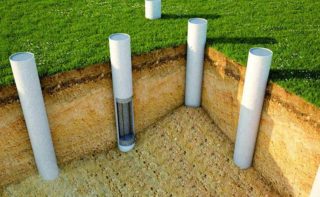
Asbestos pipes by themselves cannot bear a heavy load, they are only permanent formwork for columnar and pile structures.
There are three types of bases equipped with these products:
- columnar, shallow;
- piled with a fill below the level of soil freezing;
- columnar or pile with the arrangement of the grillage.
The first type is suitable for small buildings - sheds, temporary storage facilities. A piping is laid on the top of the pipes, on which walls of wood, CSS slabs, frame buildings and houses from sandwich panels are built.
The pile foundation can be applied on heaving soils, lands with a close occurrence of groundwater, flooded areas. On slopes, it is also more profitable to make a pile foundation, since the height of the piles is easy to adjust the level of laying the supporting beam (channel).
The combination of piles and grillage significantly increases the bearing capacity by redistributing the load to the entire foundation strip.
Pros and cons of pile and columnar foundations
Pile foundations have a number of advantages:
- low cost compared to tape plate type;
- long service life, which is enough for the entire operation cycle of the building;
- application on any type of soil, including flooded land;
- the minimum number of preparatory activities;
- ease of installation, 2-3 people are enough for work;
- versatility;
- construction speed.
The disadvantages of structures are considered to be a large number of piles when erecting a massive structure. The arrangement of the basement is possible if the piles are installed at the bottom of a previously dug excavation.
Description, characteristics and properties of asbestos pipes
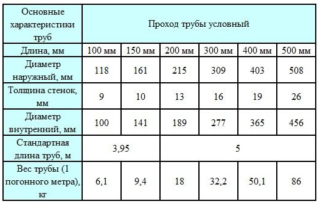
Asbestos pipes are divided into pressure and non-pressure. The first option has increased strength and a high price, which is why it is not used in the construction of foundations. These products are used for laying pressure water pipelines with pressures up to 15 atm.
Non-pressure asbestos pipes are used for arranging gravity sewer systems, laying communication cables and building drainage wells in land reclamation. The products are inexpensive and widely available.
Plants adhere to GOST 1839-80 in the manufacture. "Asbestos-cement pipes and couplings for free-flow pipelines", therefore the quality of the building material is guaranteed to be high.
In private construction, products are popular due to their positive properties. Asbestos pipes are distinguished by:
- easy processing and cutting with household tools - a hacksaw for metal or a grinder with a circle on a stone;
- moisture resistance;
- not susceptible to decay;
- low coefficient of thermal expansion, which contributes to the retention of dimensions in all weather conditions;
- resistance to chemicals and aggressive environments;
- low weight, which allows you to work without the use of lifting equipment;
- low cost;
- a wide range of standard sizes.
The downside of the pipes is their own small bearing capacity.
Manufacturers produce pipes of exact sizes. The minimum inner pipe diameter is 100 mm with a wall thickness of 9 mm. The maximum internal passage is 368 mm with a wall thickness of such a pipe of 17 mm. The outer diameters of asbestos pipes are 118, 161, 211, 307 and 402 mm. The length of the products is from 2950 to 3950 mm.
Support structure
The pipe serves as a formwork for a reinforced concrete pile. A frame made of steel reinforcement is installed inside the pipe. The number of longitudinal rods is from 1 to 4. For stability and preservation of the shape of the frame when pouring concrete, the longitudinal rods are scalded with transverse rods.
The thickness of the longitudinal rods is from 8 to 12 mm. Concrete grade for pouring is not lower than M200.
Calculation of the number of pipes
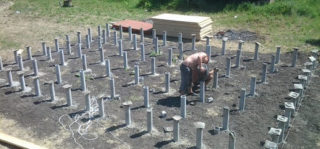
The number of piles in the foundation depends on several parameters:
- the total mass of the building, taking into account the walls, floors, roof and snow load, as well as furniture and equipment that will be placed in the premises;
- structure and bearing capacity of the soil;
- pile base diameter.
Structures must be installed at the corners of the building, as well as at the intersection of external and internal walls. It depends on the calculations how many piles will need to be installed along the walls.
The maximum distance between the posts cannot exceed 2 meters, and the minimum distance is at least three pipe diameters.
Algorithm for calculating the required number of pipes:
- Calculate the total weight of the house.
- Find out the bearing capacity of the soil at the place of construction. It can be found in reference books.
- Divide the total mass of the structure in kg by the bearing capacity of the soil, taken in kg / cm2. As a result, the total cut area of the pipes is obtained.
- By dividing the required area of the base by the area of one pile, they get the required number.
To build the foundation, the pipes must be buried in the ground below the freezing level, which is recognized from the tables for their area. The height of the snow cover is added to the resulting length so that the house does not get covered with snow.
If the asbestos-cement piles will be reinforced, multiple pipe lengths can be used.
Required amount of materials
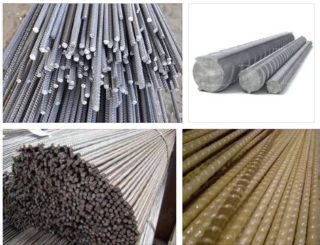
When making a foundation from asbestos-cement pipes with your own hands, you need to purchase cement, sand and steel reinforcement in advance. When buying reinforcement, take into account the length of all piles. In some cases, the rods are released from the pipe in order to weld the supporting channel of the strapping to it.
If a grillage is made around the pile foundation, its bundle with the pillars is also made due to the release of horizontal sections of reinforcement.
A stock of bars will be required if the rebars have to be joined. In this case, the overlap should be 30 bar diameters. For example, reinforcement rods with a diameter of 10 mm should overlap each other by 30 cm.
The amount of concrete required is calculated from the sum of the volumes of the cavities of all pipes.
The volume of the mixture for one rack is calculated by the formula: V = 3.14 * R2 * Lwhere V - the volume of concrete to be poured, R - inner radius of the pipe, L - length.
Materials for concrete
Asbestos pipes for the foundation are poured with concrete of the M200 or M300 brand.
Composition of concrete for obtaining 1 cubic meter of mixture from M400 cement.
| Components | M200 concrete | M300 concrete |
| Cement, kg | 260 | 340 |
| Crushed stone, kg | 1270 | 1250 |
| Sand, kg | 740 | 640 |
| Water, l | 130 | 220 |
Proportions when using cement grade M400.
| Components | M200 concrete | M300 concrete |
| Cement, kg | 1 | 1 |
| Crushed stone, kg | 4,8 | 3,7 |
| Sand, kg | 2,8 | 1,8 |
| Water, l | 0,5 | 0,6 |
Usually, concrete components for self-construction are measured in buckets.
The proportions (cement / crushed stone / sand) for concrete grade M200 - 1x3.9x2.5, and for M300 - 1x2.5x1.6.
Installation sequence
Foundation arrangement consists of several sequential procedures:
- carrying out the necessary calculations;
- purchase and delivery of building materials;
- site preparation and marking of pile locations;
- soil drilling, formation of pits for supports;
- installation of piles and their concreting.
A set of building materials, including asbestos pipes for the foundation, can be bought in one place, saving money on shipping.
Prior to the start of construction, they resolve issues with connecting to power grids and the method of delivering technical water to the site.
Preparatory work on the ground
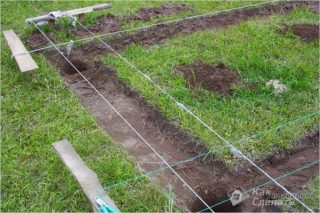
Algorithm for preparing the construction site:
- They clean the site, access roads and approaches from vegetation, large stones, construction waste.
- They remove 20-30 cm of fertile soil, uproot overgrowth of trees and bushes - after construction, it will be difficult to deal with vegetation under the floor of the first floor.
- They mark the boundaries of the future building by installing casing boards and pulling on the construction cord.
- The exact location of the piles is noted.
- The marking accuracy is checked by checking the length of the diagonals.
After preparing the construction site, they begin to arrange the foundation.
Pit preparation
Asbestos pipes for the foundation are installed in pre-prepared pits.
The borehole length should be 20-30 cm longer than the pile length. The hole diameter is chosen 10 cm larger than the diameter of the asbestos pipe. You can make holes in the ground using hand drills or gasoline units. To lengthen the working part, special extensions are used.
It is necessary to follow the safety rules without deviations when working with power tools. Tree roots, large stones can jam the drill and lead to injuries - stopping the rotation of the engine instantly will not work, the torque is enough to throw a person several meters to the side.
If necessary, the bottom of the hole is expanded using a TISE device. This allows you to increase the pile support area, increasing the design load.
10-15 cm of crushed stone is poured into the bottom of the pit and rammed with a block attached to the handle of the required length. A layer of sand 15 cm high is laid on top of the crushed stone, which is spilled with water and rammed for compaction.
Installation of piles
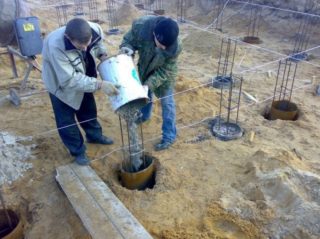
Step-by-step algorithm for installing pile foundations:
- an asbestos pipe is lowered into the prepared pit;
- align the structure vertically;
- to fix the position between the walls of the pipe and the ground, wooden wedges are installed;
- the void around the walls is covered with sand, each layer 20-30 cm thick is spilled with water and compacted using a bar;
- the reinforcement frame is assembled, which is lowered into the pipe;
- if necessary, studs are welded to the fittings for fastening the strapping;
- prepared concrete is poured into an asbestos pipe, ramming it with bars.
After the concrete has hardened, they begin to arrange the strapping or grillage.
It is up to a novice master to independently make a pile foundation from asbestos pipes. This will save money, while obtaining a reliable durable foundation for the future construction.

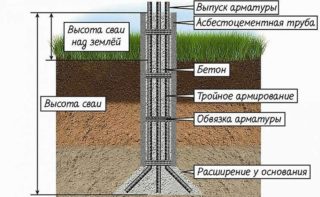








And do not need to reinforce ???